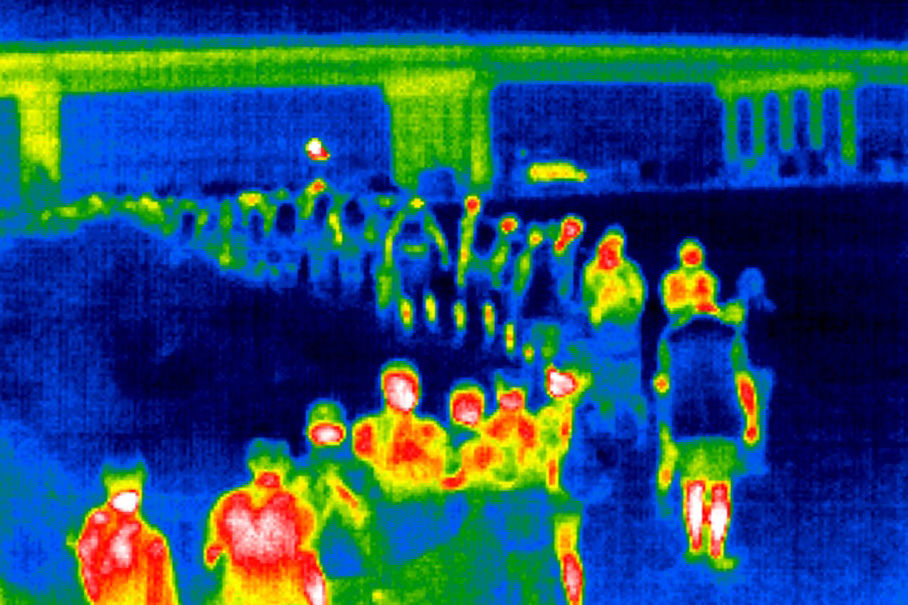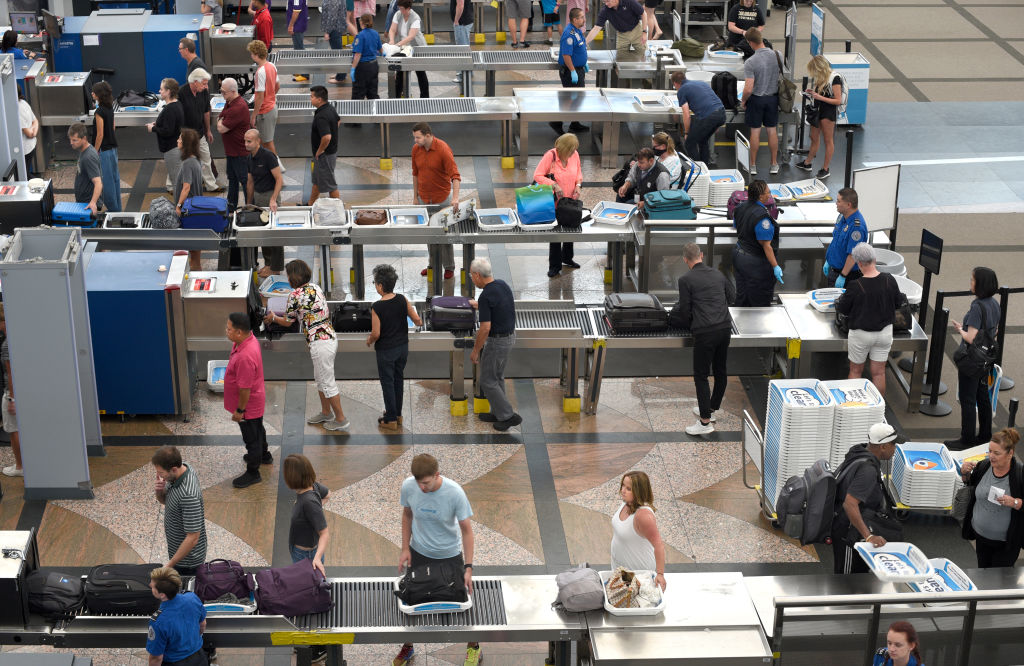Since we no longer have borders there is no need for safety theater.
Migration Is Invasion

If you don’t have borders, you don’t have a nation.
As the situation at the Texas/Mexico border continues to deteriorate, the premise of federalism is being tested in ways not seen in more than a century. The Biden Administration has openly refused any real effort to slow illegal entries, while as many as 13 million foreigners have crossed illegally since his inauguration. It took Texas longer than it should have to grasp that they were actually working to facilitate illegal entries. Eventually, though, Governor Greg Abbott recognized that the Lone Star State would have to act alone against Biden’s open border policy. After he implemented aggressive actions to stop the flow, the feds went to extraordinary measures to ensure that the border would remain open, cutting razor wire placed along the Rio Grande and doggedly fighting Abbott’s policies in federal court.
A major escalation occurred when the governor formally declared the situation an “invasion.” Predictably, Democrats howled at the use of a term with such rhetorical force. But if “invasion” is a faithful characterization of what is happening, then we have an obligation to call it that. And if there is an invasion at the southern border, then it must be stopped by all means—whether by federal intervention or in defiance of it.
What exactly constitutes an “invasion”? What are the characteristics that have defined invasions throughout human history? I propose that there are five. The first is that an invasion is something that the inhabitants of the nation being invaded never requested or invited. Second, invading forces are comprised predominantly of military-aged men. Third, invaders are primarily motivated by self-interest. Fourth, invaders carry the insignia of their home nations with them. And, finally, an invasion must pose a genuine threat to the existing social order of the place being invaded. With these criteria in mind, let’s examine the situation at our southern border.
Who Invited You?
The first characteristic of an invasion is that the people being invaded didn’t ask for the invaders to come. The influx of Europeans to the Americas in the sixteenth century serves as a prime example. Not all of the Europeans who made the trek across the Atlantic saw conquest as the purpose of their journey. The Puritans, for example, meant only to create a habitable environment for a life of religious observance apart from the repressive order they left in England. The Spanish conquistadors, on the other hand, set out to conquer and subdue the peoples they encountered in the Americas. But regardless of their intentions, neither the Puritans nor the conquistadors were invited by the indigenous tribes of those lands.
In the same way, there has been no formal invitation for the people of Central and South America to pass through our southern border illegally. America does, in fact, invite immigrants—but it requires that they apply to do so. Advocates of unlimited immigration may argue that the United States has invited the millions who are crossing illegally. Only 40 years ago, we rewarded illegal immigrants with a mass amnesty and citizenship. Today, we allow illegal immigrants to attend our public schools (often at “in-state” tuition rates reserved for citizens); we give them driver’s licenses, welfare, and medical care. Are these benefits not an invitation? No—these are incentives, which are not the same thing.
These incentives are often extended by individual states in defiance of federal law. Chicago, New York City, and other “sanctuary cities” have declared that they will not enforce federal immigration law (though they claim it’s only to protect the illegal immigrants who have already arrived). It’s plain that these cities never intended their policy to be taken as an invitation: simply look at their outrage and complaints after states like Florida and Texas began sending them illegal immigrants.
If there’s no invitation, you’ve got an invasion.
Where Are the Women and Children?
Anyone who views photographs of the many caravans moving into Eagle Pass will immediately see that the vast majority are men—almost exclusively men between the ages of 18 and 50. Whatever women and children there are, they are outnumbered by military-aged males. This disproportionality shows that the many requests for asylum are disingenuous. When the Trump Administration began screening to determine that family groups arriving were indeed family, we learned that women and children are often used as props by unrelated men who might otherwise be rejected for asylum. The overrepresentation of men suggests these people are not refugees. If they were fleeing from war, wouldn’t the military-aged men be at home fighting? Wouldn’t the caravans be comprised mostly of women and children?
Of course, the men are (probably) not planning a military assault on Dallas or Tampa, but planned military operations are not a prerequisite for a mass migration of people to be considered an invasion. If people migrate in sufficient numbers, they may not need to attack in order to conquer the region in question. At a certain point, there are too many individuals to deport: the nation being invaded has no choice but to (attempt to) integrate the newcomers.
With or without military activity, all historical invasions have consisted overwhelmingly of men in the initial stage. Indisputably, this is what is unfolding at America’s southern border.
What Are They After?
Today’s illegal immigrants undertake a treacherous journey—and they don’t do it because they want to help American citizens. They cross the desert because they believe it will benefit them personally. We constantly hear that they are “in search of a better life.” This refrain quietly concedes that the immigrants are seeking economic advantages. They may not get rich. But they will, in all likelihood, attain a level of wealth (and various social benefits) that would have been all but impossible in their countries of origin.
Regardless of their nationality, the people in the caravans are united by one characteristic: like all invading forces, they’re motivated by self-interest.
Which Flag Do They Fly?
Just as warships or fighter jets are marked with the insignia of the nation to which they belong, all invading forces bring with them the signifiers of their home. In past eras with high immigration, newcomers to the United States willingly gave up the language of their former homes. Germans, Italians, and Poles often fully transitioned to speaking English within a generation.
In contrast, the immigrants flooding over our southern border often resist assimilation—and are encouraged to do so. There are people who have been in the United States illegally for decades who still know almost no English. These people often live a life apart from the nation at large, congregating in particular neighborhoods in our major cities. But their attempts to hold onto their language and the norms of the homes they left are not the only indications they are invaders.
Who can ignore the fact that the people leading the caravans carry the flags of their homeland? Flags from Honduras, Guatemala, Mexico, and El Salvador are all on display in media images of the new arrivals. This affinity remains once they are in the United States. When the U.S. soccer team plays Mexico in California, it amounts to a home game for the Mexican team. Given a choice between the nation they left and the nation they chose instead, many “Mexican-Americans” choose to cheer for Mexico rather than America. Drive around a city with a high immigrant population like Houston, Los Angeles, or Orlando and you will see a surprising number of cars with stickers that pay homage to the home they abandoned: Mexican flags, geographical outlines of central American nations, and the like.
This resistance to assimilation—a resistance that is indulged and enabled by both public and private institutions—is a key sign that the people arriving illegally are invaders. For many, the aim isn’t to become Americans: it is to exploit the opportunities that America affords, and then to send the money earned to their families who still live back in their (true) home.
A New America?
All invasions change the way of life in the region they invade. The European invasion of the Americas completely transformed the Western hemisphere. A century after England renounced its claim to India, the signs of its invasion are still seen throughout Indian society.
The idea of the “melting pot”—an American metaphor for cultural assimilation in which the many peoples who come here become one—is now seen as a form of cultural chauvinism. Since the nineties, the dominant metaphor has been the “salad bowl,” where all the different peoples who inhabit the United States retain their various identities despite living in close geographical proximity to one another. The people who insist that “diversity is our strength” are often the same ones who assure us that mass immigration will have no discernible effect on American society.
How many more Central Americans—many of whom will not be readily assimilated—can we add to the bowl before it becomes a different sort of salad? A million? Ten million? Twenty? None of the proponents of unfettered immigration will even entertain the idea that there might be a tipping point, but there are signs that we are quickly approaching it. The recent arrival of relatively insignificant numbers of illegal immigrants in New York City and Chicago have been enough to spark housing crises, budgetary strain, and a rash of public violence that is (somehow) worse than the already-demoralizing norm.
Many who cross illegally leave their home nations because they are poor. Even when working illegally in the U.S., many still fall below the poverty line, so they are often dependent on the welfare state. In these situations, housing, food, health care, and court costs are all paid by the state, which is to say “taxpayers.”
Whether or not illegal immigrants intend to change America, they are. How much life in the nation will change depends on how long citizens tolerate the crisis. But the American way of life is already being transformed, and this shows that it amounts to an invasion.
Where There’s a Will, There’s a Way
It’s true that invasion is a strong word. But by any historically-informed perspective, it is the right word. Shying away from it amounts to a refusal to acknowledge the gravity of the problem. In the face of a world-historical tide of illegal migration, any term other than invasion is just a strategy that allows one to look away from the humanitarian catastrophe happening at the border and along the way. It’s a failure of courage—a feigned blindness that deliberately ignores the onerous ramifications that the crisis has for our own citizens and the safety of those who attempt the dangerous journey to America.
If we have any prospects of thwarting the invasion—indeed, if we are even to discover the will to do so—we and our leaders need to find the strength to admit it is happening.
The American Mind presents a range of perspectives. Views are writers’ own and do not necessarily represent those of The Claremont Institute.
The American Mind is a publication of the Claremont Institute, a non-profit 501(c)(3) organization, dedicated to restoring the principles of the American Founding to their rightful, preeminent authority in our national life. Interested in supporting our work? Gifts to the Claremont Institute are tax-deductible.
Chronic counterterrorism lapses at the border demand investigation and congressional intervention.
The leadership of our neighbor to the south treats the cartels as a useful ally.
Republican voters’ trust in their own elected leaders is plummeting.
The conclusion of a report from the Southern border.
America increasingly resembles a failed state.






